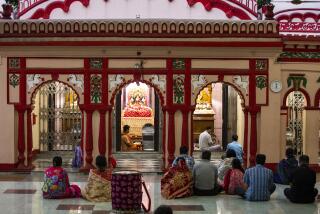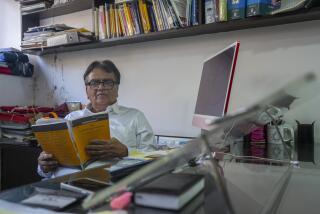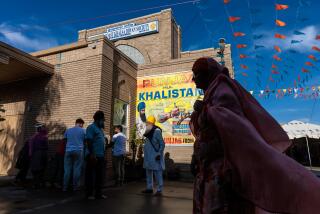India Unbowed, Despite Constant Ethnic Strife
NEW DELHI — The news in India had a sad but familiar ring: Another ethnic minority was rebelling. Yet another tile was loose in the Indian mosaic.
This time, it was the tiny former Portuguese colony of Goa--normally an insouciant land known for its sunny beaches and potent palm toddy--that was in the throes of an ethnic uprising.
A group calling itself the Konkani Porjecho Avaz (Konkani People’s Voice) insisted that the native Konkani-speaking people of Goa have been overrun by Marathi-speaking “foreigners” from the neighboring state of Maharashtra.
The Konkanis demanded that Goa, now administered as a federal territory, be given statehood and that the Konkani language be declared its official language. As usual, there was an underlying religious motif, for most Konkanis are Christians and most of the Maharashtrans are Hindu.
So fierce were emotions that there were several deaths reported in the days before Christmas. More violence was reported on Christmas Day in which seven people were seriously injured after the two sides again clashed, marring holiday festivities.
The Konkani uprising was another of the countless ethnic conflicts raging in India. In some other society, such relentless clashes would be interpreted as signs of imminent disintegration. Certainly these conflicts, with their flashing blades and automatic gunfire, dominate the reporting of both the Indian and foreign press.
Yet inside India, such fighting has become part of the status quo. Leon Trotsky dreamed of a “permanent revolution.” Indians find themselves in a state of permanent internal conflict.
Twenty years ago, the conflicts were in Tamil Nadu and Maharashtra and Nagaland and Punjab, causing then-Prime Minister Jawaharlal Nehru to complain in a 1955 letter to Lady Mountbatten, wife of the former British viceroy, “This is a terrible job and I do not see much light yet.”
Life Goes On
Today, the conflicts are in Punjab again and Bengal and yes, even sunny little Goa.
However, instead of destroying India, as Nehru feared and many analysts predicted when India gained its independence in 1947, the constant warring of ethnic interests has actually had little measurable impact on national integrity. Not one inch of Indian territory has been lost to an ethnic nationalist movement.
Despite the agonizing ethnic disputes--such as the one in Punjab that recently resulted in the slaughter of 22 unarmed bus passengers by Sikh terrorists--most of the Indian body politic remains intact. In short, for most of India’s 780 million people, life goes on unaffected by the trauma of these bitter divisions.
And while the front pages of the newspapers here may be dominated by the Sikh-Hindu hatreds in Amritsar or the Muslim angers in Bangalore, the inside pages also speak of an India where a Muslim is the new young star of the Indian cricket team, a Christian is the chief of the Indian air force and a Sikh wins the New Delhi marathon.
Sikhs Alongside Hindus
Sometimes, amid the turmoil of the latest uprising, it is easy to forget that the president of India, Giani Zail Singh, is a Sikh and that Prime Minister Rajiv Gandhi, the son of a Zoroastrian (a member of the ancient fire-worshiping cult), is not technically a high-caste Hindu like his mother, Indira Gandhi, or his grandfather, Jawaharlal Nehru. There are, in fact, no pure Hindus at the top positions of the Indian government.
And, in the famous hive-like bureaucracies of the Indian capital, Sikhs work alongside Hindus, high-caste Brahmans toil alongside non-caste harijans, Muslims take tea breaks with animists from Gujarat.
Meeting with a foreign reporter recently, a senior government official in charge of the famous Indian elite cadre of bureaucrats, the Indian Administrative Service, read aloud from a list of those who had achieved the highest scores on the civil service exam--and members of all of India’s diverse communities were included.
Army Melting Pot
Likewise, the 1 million-member Indian army, unique in South Asia, is representative of India’s diverse culture. The army melting pot includes seven major religions, 33 main languages, 1,652 dialects and hundreds of castes and social orders--a sharp contrast to the army in neighboring Pakistan, which is dominated by men from the Pakistan Punjab, and army in Sri Lanka, which is run by the majority Sinhalese Buddhists.
In the arts, minorities, including Sikhs and Muslims, are box-office stars. A Muslim woman, Shabana Azami, is perhaps the country’s most famous actress. A young Muslim, Zakir Hussain, may be India’s finest tabla drum player.
The national cricket team with its new young Muslim star, Mohammed Azharuddin, is a cross section of India. The 11-man cricket side includes representatives of four religions (Hinduism, Islam, Sikhism and Christianity), several castes, six different languages and five written scripts.
So at some levels, at least, the Indian melting pot--so complex it makes the American model look like a saucepan--is sometimes realized.
Vast Differences
“We really haven’t done that badly,” said Dr. Pai Panandikar, director of the Center for Policy Research in New Delhi. “If you look at the diversity of the country, you are virtually looking at more than 22 different countries with vast ethnic and religious differences. There are inherent problems, and we will have turbulence from time to time because of the socioeconomic and political change that is taking place in the traditional society. Especially compared to other developing countries, we have a good record in managing this turbulence.”
Of course, by emphasizing the melting pot aspect of Indian society, academicians do not mean to minimize the ethnic conflicts.
Perhaps more than in other societies, in fact, India seems capable of balancing these two phenomena in much the way that the creative and destructive elements are harnessed in some of the Hindu gods. It is this element that is hardest to explain to an outsider peering for the first time into Indian society.
In his later years as prime minister, Nehru appeared to understand this paradox.
‘Always Two Aspects’
“In India,” Nehru said in a 1960 speech, “we always have two aspects: One is heartening and enlivening, the growth of a great country struggling under adverse circumstances and making good; the other is this lowering of spirit, the absence of idealism and living confined to one’s petty self and the growth of all manner of narrow-minded, petty jealousies.”
Like his mother before him, Rajiv Gandhi’s method for dealing with these internal disturbances is to blame them on outside forces, the so-called “foreign hand.” In this way, Gandhi deflects criticism of his own government. Gandhi claims that the Punjab problem, for example, is the result of archrival Pakistan’s training of Sikh terrorists. Likewise, the Gurkhaland movement in Darjeeling is said to be the work of intrigue from Nepal.
“India is not coming apart at the seams,” explained one senior official, reflecting the Gandhi line, “but outside people are pulling at the seams.”
There are some Indian academicians who argue that India’s awesome diversity, in fact, acts as a glue to hold the country together.
Diversity Helps
A senior military official confided recently a pet theory for why India has never been threatened by a military coup d’etat. “The best argument against a military coup is that no commander can expect to take all the communities represented in the ranks with him,” he said.
T.K. Oommen, a sociology professor and an expert on Indian ethnicity at Jawaharlal Nehru University, agrees on a more general level. “The very diversity and size of India make it possible for a lot of tension to be absorbed,” he said. “It also gives a government huge leverage in system management.”
Still, to an outsider reading the bloody news accounts, India must appear a sea of hatreds and turmoil--a place, like the one in an old Kingston Trio song, where “the whole world is festering with unhappy souls.”
Indeed, keeping track of India’s various rebellions, their impassioned leaders and gruesome tolls requires the discipline of a statistician.
Similar Goals
In one week of December, for example, Sikh terrorists killed the 22 bus passengers in Punjab, insurgents with the tribal national volunteers murdered 13 non-tribal persons in Tripura and more than a dozen Muslims were killed in rioting in Bangalore set off by a local newspaper’s publication of a story entitled “Mohammed the Idiot,” a fictional account of a village simpleton.
Strangely enough, as disparate as these events may seem, there is a unity of sorts in the kinds of recognition the various groups are seeking.
The complaints of the Konkanis against the Maharashtrans, for example, are very similar to the complaints of the Maharashtrans against the Gujaratis in Bombay, a few hundred miles up the coast from Goa.
In fact, the fevered pleas of the Goan Konkanis, India’s newest ethnic interest group, are not all that much different from those of the Gurkhas in Darjeeling, the Mizos of Mizoram, the Tribals of Tripura, the Muslims of Kashmir, the Hindus of Kashmir, the Muslims of Karanataka, the Tamils of Tamil Nadu and even the Sikhs of Punjab--the scene of India’s bloodiest ethnic conflict. Every one of these movements is born out of some real or imagined slight by another of the hundreds of Indian ethnic divisions.
Violence Is Not New
Yet as shocking as some of these situations might seem, they are certainly not new to the Indian landscape. At the time of independence, as many as 2 million persons, primarily Muslims, Sikhs and Hindus, were killed during the bloody partition of British India into Pakistan and modern India.
Some intellectuals claim that the ethnic conflicts that plague India have become more violent than the ones that flared in the time of Nehru.
“The bitterness and the bloodiness of the conflicts, the multiplicity and complexity, is a great deal greater,” said Pran Chopra of the Center for Policy Research.
About 3,000 Muslims, for example, were massacred by Assamese tribals in 1983 near the town of Nellie. Another 2,000 Sikhs died in the rioting following the assassination of Indira Gandhi in 1984; Sikhs were the target because she was killed by her Sikh bodyguards.
Relatively Few Deaths
Despite the sensational nature of some of the killings, however, the actual number of deaths in most of these conflicts is relatively low. For example, in this, the most violent year of the ongoing Punjab conflict, 550 persons have been killed in the state.
To put this in perspective: Punjab has a population of 16 million, yet the number of people killed there in violence is less than the number of murders in Detroit or Dallas, both of which have populations under 1 million.
A senior Indian government official put it another way: “This year in Uttar Pradesh (a large northern Indian state), more than 600 women were killed in disputes over dowry--more than (died) in Punjab (violence).”
While there probably has been an increase in the level of violence that accompanies these constant ethnic conflicts, there has also been, said Chopra, a growth of “homogenizing factors” in Indian society--such as television and mass marketing of products--that tend to bring the country closer together.
A Difficult Task
“We are all much more homogenized in matter of dress, food habits and knowledge of different parts of the country through travel than we have ever been before,” Chopra said.
A growing middle class also is a factor in preserving national integrity. “The middle class has an investment in the stability of the country,” Chopra said.
In addition, there appears to be a growing recognition that India will never be able to free itself from its ethnic wars.
“National integration is an extremely difficult, if not altogether impossible task,” wrote Ram Jethmalani, a columnist for the Indian Express chain of newspapers. “Friction, violence and even bloodshed cannot be totally eliminated and must recur from time to time. We must be content with a more modest objective.”
The objective, Jethmalani suggested, would be for Indians to pull together in times of war or natural disaster. Indians, he said, may be forever feuding among themselves. But if they can be trusted to unite against a foreign enemy, “we will have achieved what we possibly can,” he said.
More to Read
Sign up for Essential California
The most important California stories and recommendations in your inbox every morning.
You may occasionally receive promotional content from the Los Angeles Times.










